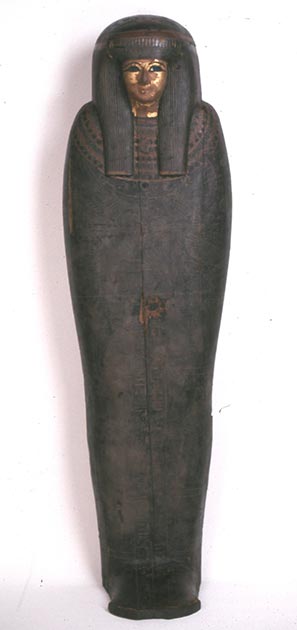
Mysterious “Black Goo” Of Egyptian Burials Demystified
Dr Kate Fulcher is a Research Assistant in the British Museum's Department of Scientific Research, and she led a research project to identify the “black goo” in Egyptian burials, and what it might reveal about ancient Egyptian funerary practices and rituals.
An article on the British Museum’s website described the burial of Djedkhonsiu-ef-ankh, an ancient Egyptian high priest who served as the “Opener of the Doors of Heaven” at the Temple of Amun at Karnak almost 3,000 years ago. This title means he was the gatekeeper of the temple sanctuary shrine in which the cult image of the god resided and according to Dodson and Hilton’s 2004 book The Complete Royal Families of Ancient Egypt, Djedkhonsiu-ef-ankh was wrapped in linen cloths, mummified and buried in Deir el-Bahari, a complex of mortuary temples and tombs located on the west bank of the Egyptian Nile, opposite the city of Luxor.
Technicolor Black
The high priest’s face was covered in gold leaf and his mummy case was painted in bright colors before it was placed into its coffin, then carried to the tomb. British Museum scientists describe “several liters of warm black goo” being poured all over the mummy case, cementing it into the coffin before the lid was placed, allowing the priest to journey into the underworld in a ‘hermetically-sealed' container.

Mummy of Djedkhonsiufankh. The mummy, when acquired, was in a gilded cartonnage mummy-case and wooden coffin with a gilded face and inlaid glass (© The Trustees of the British Museum / CC BY NC-SA 4.0)
Black Goo Depended On Imported Plant Materials
The mysterious ‘black goo’ has been found in a number of ancient Egyptian burials but now over 100 samples from twelve coffins and mummy cases, dating to the 22nd Dynasty (c. 900–750 BC), were chemically analyzed in 2020 in the British Museum science labs located beneath the museum in London. The method of analysis was Gas Chromatography – Mass Spectrometry in which vaporized goo samples were forced into a mass spectrometer which separates them according to their mass to charge ratio, revealing the types and amount of molecules present in the samples.
Testing determined the goo was a composition of “plant oils, animal fats, tree resins, beeswax and bitumen (crude oil)” and the museum scientists said other materials may have been present in the goo but that they have vanished over the last 3,000 years.
The researchers said that some of these ingredients “only naturally occur outside of Egypt,” indicating they had been imported and they said the two tree resins were from conifer trees and pistacia, the later of which grows around the Mediterranean, from Greece to Western Asia.
- Over 20,000 Have Petitioned to Drink the ‘Pharaoh Punch’ of the Black Sarcophagus
- Sarcophagus of Egyptian High Priest Unearthed with Hieroglyphic Inscriptions and Scenes of Offerings
- Coffin Pieced Together Reveals Egyptian Princess Face

The wooden coffin was also covered in black goo. (© The Trustees of the British Museum / CC BY NC-SA 4.0)
Examining the bitumen biomarkers in the goo samples revealed it had been imported from the Dead Sea, which the researchers says makes sense because ancient Greek texts refer to “solid blocks of bitumen floating to the surface of the Dead Sea” and they record sailors rowing out to collect it for selling in Egypt.
Spiritual Goo For The Elites That Could Afford it
What then was this mysterious black goo’s practical purpose, or spiritual meaning? The museum scientists are still unclear about this but they say previous analyses of mummification balms shows it was made of the same ingredients as the black goo. This means it was applied at different points in the burial process, from the ritual preparation of the dead body to when it was poured onto the mummy cases and coffins. And the researchers suggested the color of the goo, black, represented the dead taking on a form of Osiris, the god death and rebirth known as “the black one.” What’s more, according to the museum scientists, black is also the color associated with the alluvial silt deposited on the banks of the River Nile after the annual flood receded which was believed to be “inherently magical and regenerative.”
The scientists’ study also demonstrated that black goo was reserved for the burial of social elites which is apparent in that most of the earliest goo samples were found in royal burials, for example, Tutankhamun’s innermost gold coffin was cemented into the middle coffin with “bucketfulls of black goo”. Examples of the use of black goo are more common in the Third Intermediate Period (c. 1069 BC–c. 664 BC), which the researchers think either relates to changes in funerary practices, or perhaps because more recovered coffins from this time are in good states of preservation.
Top image: The black go used in Egyptian burials has been analyzed. Source: ©The Trustees of the British Museum / CC BY-NC-SA 4.0
By Ashley Cowie
















Comments
So - black was considered 'special' by the Egyptians....funny how that has now reversed, but it shows how the blacker skins of the Sudanese area's peoples did not prevent them from becoming Pharoahs - I had often wondered how that worked, but the racism we are all full of in the current West, has been said to be pretty recent, and this certainly looks like confirmation of that fact.